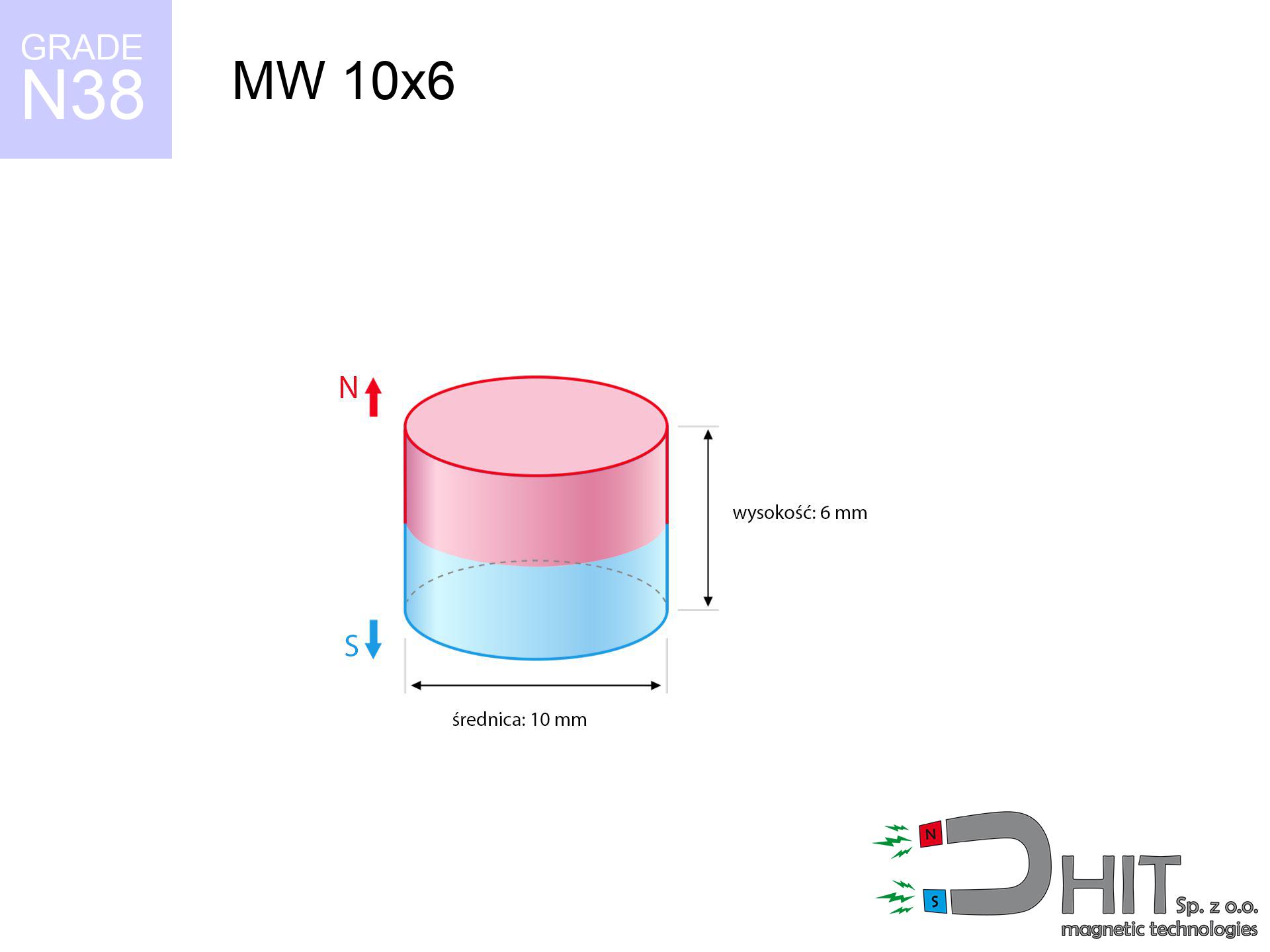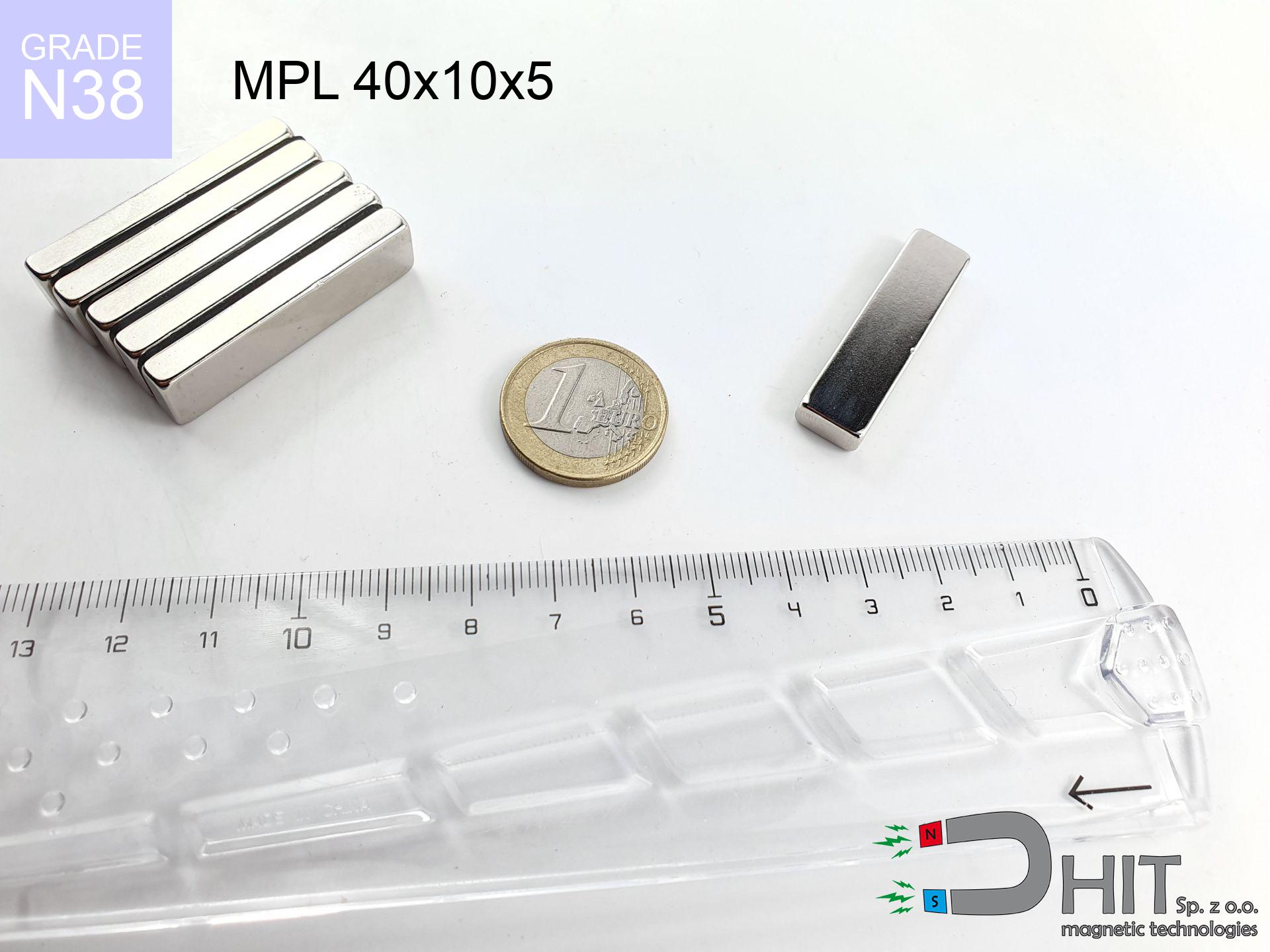MW 10x6 / N38 - cylindrical magnet
cylindrical magnet
Catalog no 010012
GTIN: 5906301810117
Diameter Ø [±0,1 mm]
10 mm
Height [±0,1 mm]
6 mm
Weight
3.53 g
Magnetization Direction
↑ axial
Load capacity
3.32 kg / 32.56 N
Magnetic Induction
475.73 mT
Coating
[NiCuNi] nickel
1.045 ZŁ with VAT / pcs + price for transport
0.850 ZŁ net + 23% VAT / pcs
bulk discounts:
Need more?Need advice?
Pick up the phone and ask
+48 22 499 98 98
or let us know by means of
inquiry form
the contact form page.
Strength as well as structure of a neodymium magnet can be calculated with our
force calculator.
Orders submitted before 14:00 will be dispatched today!
MW 10x6 / N38 - cylindrical magnet
Magnetic properties of material N38
Physical properties of NdFeB
Shopping tips
Moreover, even though neodymium is part of the strongest magnets, they are susceptible to corrosion in humid environments. Therefore, they are coated with a thin layer of gold to increase their durability. It's worth noting that NdFeB neodymium magnets are about 13% lighter than SmCo magnets and, despite their power, are brittle, which requires care during their handling. For this reason, any mechanical processing should be done before they are magnetized.
In terms of safety, there are several recommendations regarding the use of these magnets. They should not be used in acidic, basic, organic environments or in solvents, as well as in water or oil. Additionally, they can damage data on magnetic cards and hard drives, although data deletion using a neodymium magnet is not always certain.
In terms of properties in different environments, neodymium magnets are sensitive to corrosion, especially in humid conditions. Therefore, they are often covered with coatings, such as nickel, to shield them from environmental factors and extend their lifespan. Temperatures exceeding 130°C can cause a loss of their magnetic properties, although there are specific types of neodymium magnets that can tolerate temperatures up to 230°C.
As for potential dangers, it is important to avoid using neodymium magnets in acidic conditions, basic conditions, organic or solvent environments, unless they are insulated. Additionally, their use is not recommended in water, oil, or in an environment containing hydrogen, as they may forfeit their magnetic strength.
Advantages and disadvantages of neodymium magnets NdFeB.
Apart from their superior magnetic energy, neodymium magnets have these key benefits:
- They have unchanged lifting capacity, and over around 10 years their performance decreases symbolically – ~1% (in testing),
- They show strong resistance to demagnetization from outside magnetic sources,
- By applying a reflective layer of gold, the element gains a modern look,
- They have exceptional magnetic induction on the surface of the magnet,
- With the right combination of magnetic alloys, they reach excellent thermal stability, enabling operation at or above 230°C (depending on the form),
- Thanks to the freedom in shaping and the capability to adapt to unique requirements, neodymium magnets can be created in diverse shapes and sizes, which increases their functional possibilities,
- Wide application in modern technologies – they are utilized in HDDs, electric drives, healthcare devices along with sophisticated instruments,
- Compactness – despite their small size, they provide high effectiveness, making them ideal for precision applications
Disadvantages of neodymium magnets:
- They may fracture when subjected to a sudden impact. If the magnets are exposed to shocks, it is advisable to use in a protective enclosure. The steel housing, in the form of a holder, protects the magnet from cracks while also enhances its overall strength,
- Magnets lose magnetic efficiency when exposed to temperatures exceeding 80°C. In most cases, this leads to irreversible power drop (influenced by the magnet’s profile). To address this, we provide [AH] models with superior thermal resistance, able to operate even at 230°C or more,
- They rust in a humid environment, especially when used outside, we recommend using sealed magnets, such as those made of non-metallic materials,
- Using a cover – such as a magnetic holder – is advised due to the limitations in manufacturing threads directly in the magnet,
- Health risk linked to microscopic shards may arise, if ingested accidentally, which is important in the protection of children. Furthermore, small elements from these magnets can hinder health screening once in the system,
- High unit cost – neodymium magnets are more expensive than other types of magnets (e.g., ferrite), which increases the cost of large-scale applications
Best holding force of the magnet in ideal parameters – what contributes to it?
The given strength of the magnet corresponds to the optimal strength, measured in the best circumstances, specifically:
- using a steel plate with low carbon content, acting as a magnetic circuit closure
- with a thickness of minimum 10 mm
- with a smooth surface
- with zero air gap
- with vertical force applied
- under standard ambient temperature
Key elements affecting lifting force
In practice, the holding capacity of a magnet is affected by these factors, in descending order of importance:
- Air gap between the magnet and the plate, because even a very small distance (e.g. 0.5 mm) can cause a drop in lifting force of up to 50%.
- Direction of applied force, because the maximum lifting capacity is achieved under perpendicular application. The force required to slide the magnet along the plate is usually several times lower.
- Thickness of the plate, as a plate that is too thin causes part of the magnetic flux not to be used and to remain wasted in the air.
- Material of the plate, because higher carbon content lowers holding force, while higher iron content increases it. The best choice is steel with high magnetic permeability and high saturation induction.
- Surface of the plate, because the more smooth and polished it is, the better the contact and consequently the greater the magnetic saturation.
- Operating temperature, since all permanent magnets have a negative temperature coefficient. This means that at high temperatures they are weaker, while at sub-zero temperatures they become slightly stronger.
* Holding force was measured on a smooth steel plate of 20 mm thickness, when the force acted perpendicularly, whereas under shearing force the lifting capacity is smaller. In addition, even a slight gap {between} the magnet and the plate lowers the holding force.
Caution with Neodymium Magnets
Neodymium magnets can demagnetize at high temperatures.
Although magnets have shown to retain their effectiveness up to 80°C or 175°F, this temperature may vary depending on the type of material, shape, and intended use of the magnet.
Keep neodymium magnets away from GPS and smartphones.
Neodymium magnets generate intense magnetic fields that interfere with magnetometers and compasses used in navigation, as well as internal compasses of smartphones and GPS devices.
Comparing neodymium magnets to ferrite magnets (found in speakers), they are 10 times stronger, and their strength can shock you.
Read the information on our website on how to properly utilize neodymium magnets and avoid significant harm to your body and unintentional damage to the magnets.
People with pacemakers are advised to avoid neodymium magnets.
Neodymium magnets produce strong magnetic fields that can interfere with the operation of a heart pacemaker. Even if the magnetic field does not affect the device, it can damage its components or deactivate the entire device.
Neodymium magnets can attract to each other due to their immense internal force, causing the skin and other body parts to get pinched and resulting in significant injuries.
Magnets will attract each other within a distance of several to about 10 cm from each other. Don't put your fingers in the path of magnet attraction, as a serious injury may occur. Magnets, depending on their size, are able even cut off a finger or alternatively there can be a serious pressure or even a fracture.
The magnet coating is made of nickel, so be cautious if you have an allergy.
Studies show a small percentage of people have allergies to certain metals, including nickel. An allergic reaction often manifests as skin redness and rash. If you have a nickel allergy, you can try wearing gloves or simply avoid direct contact with nickel-plated neodymium magnets.
Dust and powder from neodymium magnets are highly flammable.
Avoid drilling or mechanical processing of neodymium magnets. Once crushed into fine powder or dust, this material becomes highly flammable.
Neodymium magnets are highly susceptible to damage, resulting in breaking.
Neodymium magnets are characterized by considerable fragility. Neodymium magnets are made of metal and coated with a shiny nickel surface, but they are not as hard as steel. In the event of a collision between two magnets, there may be a scattering of fragments in different directions. Protecting your eyes is crucial in such a situation.
You should maintain neodymium magnets at a safe distance from the wallet, computer, and TV.
Strong magnetic fields emitted by neodymium magnets can damage magnetic storage media such as floppy disks, credit cards, magnetic ID cards, cassette tapes, video tapes, or other devices. They can also damage televisions, VCRs, computer monitors, and CRT displays. Avoid placing neodymium magnets in close proximity to electronic devices.
Magnets are not toys, youngest should not play with them.
Not all neodymium magnets are toys, so do not let children play with them. In the case of small magnets, they can be swallowed and cause choking. In such cases, the only solution is to undergo surgery to remove the magnets, and otherwise, it can even lead to death.
Pay attention!
So you are aware of why neodymium magnets are so dangerous, see the article titled How very dangerous are strong neodymium magnets?.







![SM 32x250 [2xM8] / N52 - magnetic separator SM 32x250 [2xM8] / N52 - magnetic separator](https://cdn3.dhit.pl/graphics/products/sm-32x250-2xm8-guf.jpg)

